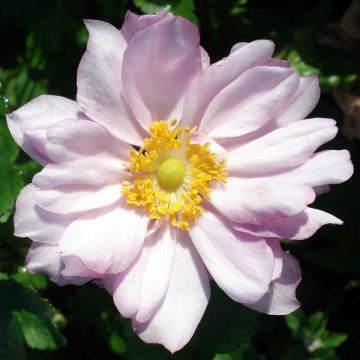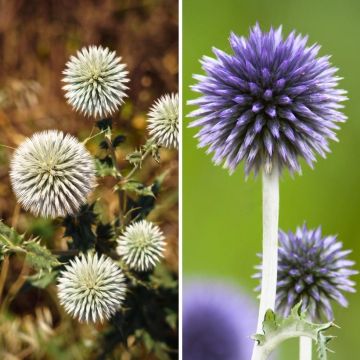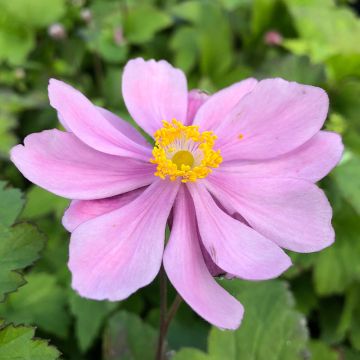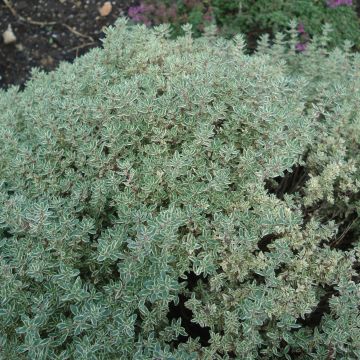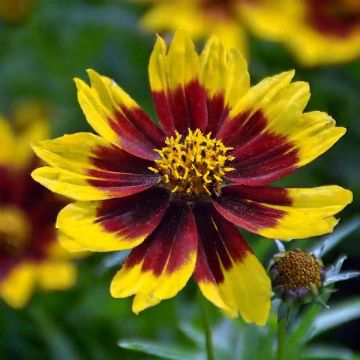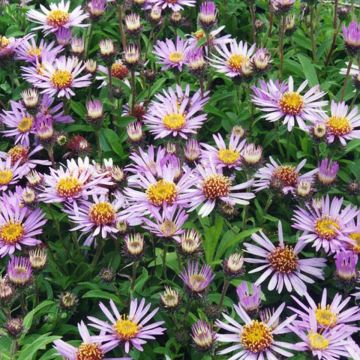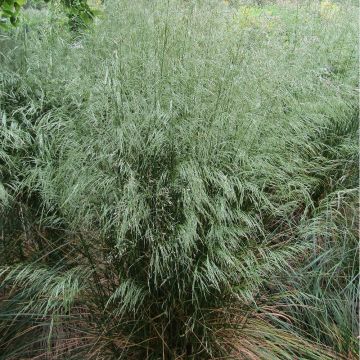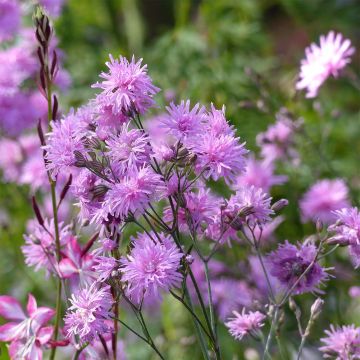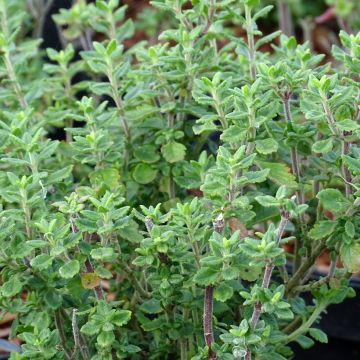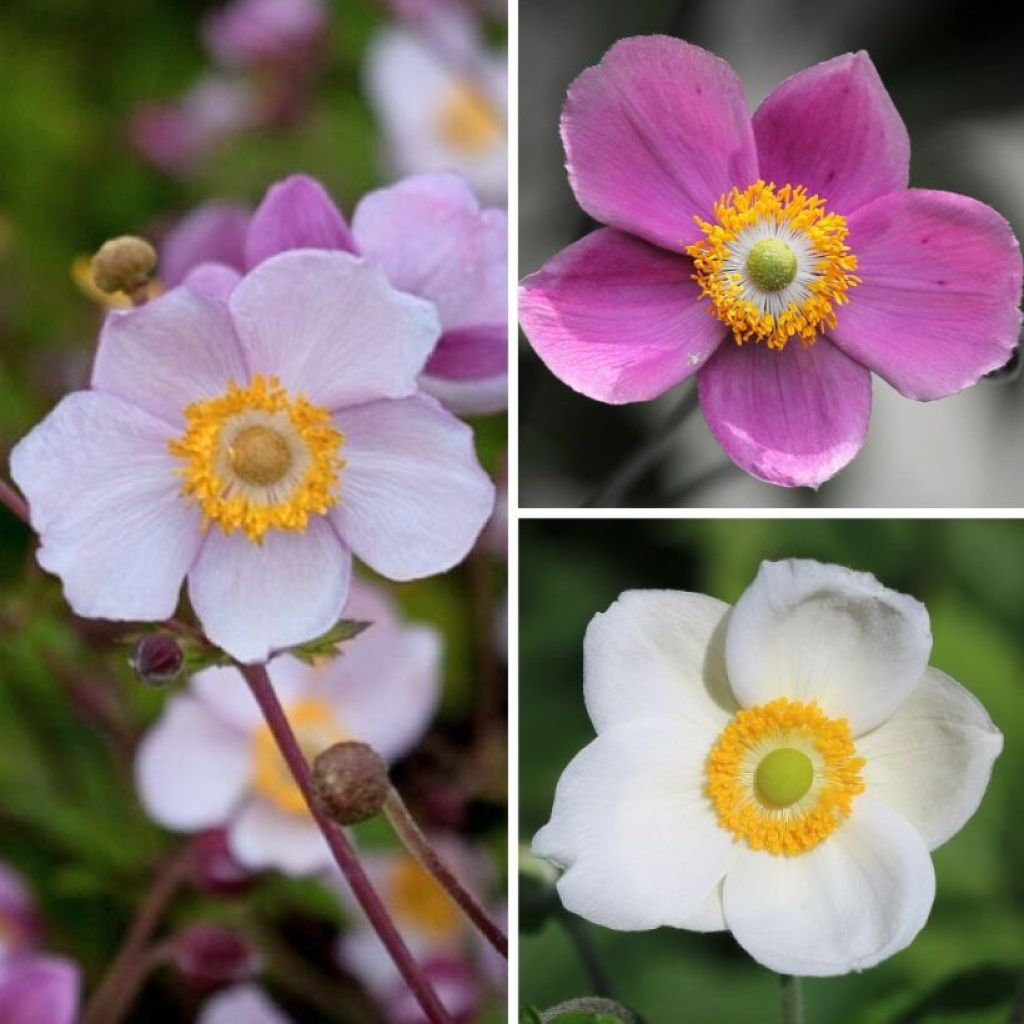

Collection of Japanese Anemones
Collection of Japanese Anemones
Anemone hupehensis Hupehensis Praecox, Hadspen Abundance, Honorine Jobert
Japanese Anemone
9 plants ordered, all arrived perfectly packaged, nice and green and vigorous with beautiful roots. They've been in the ground for 1 week in a 14m² bed with silver candles, peach-leaved campanulas and pigamons. We'll see the outcome next year when the vegetation starts again. Can't wait!!!!
Johanna, 22/10/2024
This item cannot be shipped to the selected country
Delivery charge from €5.90
More information
Schedule delivery date,
and select date in basket
This plant carries a 12 months recovery warranty
More information
We guarantee the quality of our plants for a full growing cycle, and will replace at our expense any plant that fails to recover under normal climatic and planting conditions.
From €5.90 for pickup delivery and €6.90 for home delivery
Express home delivery from €8.90.
Does this plant fit my garden?
Set up your Plantfit profile →
Collection items (3 plants)
Description
The collections comprises:
- x 1 Anemone 'Praecox': the most famous Anemone hupehensis variety, well-loved for its vigour and floribundity, but also for its large, charming, rustic flowers, in pearly pink tones, subtly scented. Flowering height: ca 1 m
- x 1 Anemone 'Hadspen Abundance': its flower stalks, straight and robust, reach a height of up to 80 cm. The flowers are dark raspberry pink, with subtle nude pink gleams, and a central cluster of golden stamens
- x 1 Anemone Honorine Jobert: a wonderful, old variety with exceptional vigour and floribundity. Its floral stems can reach up to 1.80 m and carry pure white flowers enhanced by a crown of yellow stamens. Particularly prolific and robust, it can sometimes be necessary to limit its development.
Plants labelled separately.
Extremely vigorous when grown in the right situation, Japanese anemones are well-suited to humus-rich, fertile, light and slightly humid soils. They like partial shade, but can tolerate non-scorching sun. This perennial plant thrives under the dappled shade of trees, in woodland edges or at the back of flower beds, where it forms magnificent clumps. You can grow Japanese anemones in the company of persicarias, bugbanes or easy to grow hardy geraniums. At the end of summer, Japanese anemones also pair well with tall asters or shade-loving shrubs such as Sarcococca. Occasionally invasive in ideal conditions, they self-seed easily. Fortunately, limiting their spread is also very easy.
For winter bouquets, cut the fruiting stems carrying seed capsules when they appear dry, and place them in a vase. After two hours at room temperature, pure white catkins will be revealed.
Report an error about the product description
Flowering
Foliage
Plant habit
Botanical data
Anemone
hupehensis
Hupehensis Praecox, Hadspen Abundance, Honorine Jobert
Ranunculaceae
Japanese Anemone
Cultivar or hybrid
Other Japanese Anemones
Planting and care
Plant Japanese anemones and in a part shaded or sunny spot, sheltered from the wind and scorching sun. The soil must be rich, moist or humid, but well drained, as Japanese anemones cannot tolerate stagnant humidity in winter. Also avoid soils that are too rich in limestone, which they do not tolerate well. A well-established plant generally does not need watering in summer, except in dry and hot climates.
Dig a hole slightly larger than that of the rootball, and deep so as to place a mixture of well-decomposed potting soil or compost and garden soil. Place the rootball in the planting hole and fill with the same mixture. Press lightly then water thoroughly. Space the plants 40 to 60 cm apart. During the summer, do not hesitate to water to stimulate flowering, especially in the first year. A layer of mulch will help maintain soil moisture. If you notice a drop in flowering, spread compost at the base of the plant at the beginning or end of winter. The clump benefits from being protected using a layer of leaves in regions with cold winters.
Planting period
Intended location
Care
-
, onOrder confirmed
Reply from on Promesse de fleurs
Summer flowering perennials
Haven't found what you were looking for?
Hardiness is the lowest winter temperature a plant can endure without suffering serious damage or even dying. However, hardiness is affected by location (a sheltered area, such as a patio), protection (winter cover) and soil type (hardiness is improved by well-drained soil).

Photo Sharing Terms & Conditions
In order to encourage gardeners to interact and share their experiences, Promesse de fleurs offers various media enabling content to be uploaded onto its Site - in particular via the ‘Photo sharing’ module.
The User agrees to refrain from:
- Posting any content that is illegal, prejudicial, insulting, racist, inciteful to hatred, revisionist, contrary to public decency, that infringes on privacy or on the privacy rights of third parties, in particular the publicity rights of persons and goods, intellectual property rights, or the right to privacy.
- Submitting content on behalf of a third party;
- Impersonate the identity of a third party and/or publish any personal information about a third party;
In general, the User undertakes to refrain from any unethical behaviour.
All Content (in particular text, comments, files, images, photos, videos, creative works, etc.), which may be subject to property or intellectual property rights, image or other private rights, shall remain the property of the User, subject to the limited rights granted by the terms of the licence granted by Promesse de fleurs as stated below. Users are at liberty to publish or not to publish such Content on the Site, notably via the ‘Photo Sharing’ facility, and accept that this Content shall be made public and freely accessible, notably on the Internet.
Users further acknowledge, undertake to have ,and guarantee that they hold all necessary rights and permissions to publish such material on the Site, in particular with regard to the legislation in force pertaining to any privacy, property, intellectual property, image, or contractual rights, or rights of any other nature. By publishing such Content on the Site, Users acknowledge accepting full liability as publishers of the Content within the meaning of the law, and grant Promesse de fleurs, free of charge, an inclusive, worldwide licence for the said Content for the entire duration of its publication, including all reproduction, representation, up/downloading, displaying, performing, transmission, and storage rights.
Users also grant permission for their name to be linked to the Content and accept that this link may not always be made available.
By engaging in posting material, Users consent to their Content becoming automatically accessible on the Internet, in particular on other sites and/or blogs and/or web pages of the Promesse de fleurs site, including in particular social pages and the Promesse de fleurs catalogue.
Users may secure the removal of entrusted content free of charge by issuing a simple request via our contact form.
The flowering period indicated on our website applies to countries and regions located in USDA zone 8 (France, the United Kingdom, Ireland, the Netherlands, etc.)
It will vary according to where you live:
- In zones 9 to 10 (Italy, Spain, Greece, etc.), flowering will occur about 2 to 4 weeks earlier.
- In zones 6 to 7 (Germany, Poland, Slovenia, and lower mountainous regions), flowering will be delayed by 2 to 3 weeks.
- In zone 5 (Central Europe, Scandinavia), blooming will be delayed by 3 to 5 weeks.
In temperate climates, pruning of spring-flowering shrubs (forsythia, spireas, etc.) should be done just after flowering.
Pruning of summer-flowering shrubs (Indian Lilac, Perovskia, etc.) can be done in winter or spring.
In cold regions as well as with frost-sensitive plants, avoid pruning too early when severe frosts may still occur.
The planting period indicated on our website applies to countries and regions located in USDA zone 8 (France, United Kingdom, Ireland, Netherlands).
It will vary according to where you live:
- In Mediterranean zones (Marseille, Madrid, Milan, etc.), autumn and winter are the best planting periods.
- In continental zones (Strasbourg, Munich, Vienna, etc.), delay planting by 2 to 3 weeks in spring and bring it forward by 2 to 4 weeks in autumn.
- In mountainous regions (the Alps, Pyrenees, Carpathians, etc.), it is best to plant in late spring (May-June) or late summer (August-September).
The harvesting period indicated on our website applies to countries and regions in USDA zone 8 (France, England, Ireland, the Netherlands).
In colder areas (Scandinavia, Poland, Austria...) fruit and vegetable harvests are likely to be delayed by 3-4 weeks.
In warmer areas (Italy, Spain, Greece, etc.), harvesting will probably take place earlier, depending on weather conditions.
The sowing periods indicated on our website apply to countries and regions within USDA Zone 8 (France, UK, Ireland, Netherlands).
In colder areas (Scandinavia, Poland, Austria...), delay any outdoor sowing by 3-4 weeks, or sow under glass.
In warmer climes (Italy, Spain, Greece, etc.), bring outdoor sowing forward by a few weeks.







































